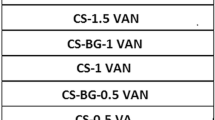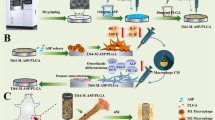Abstract
Enhanced antiinfection activities, improved hemocompatibility and osteo-compatibility, and reinforced osseointegration are among the most important considerations in designing multifunctional orthopedic biomaterials. Hereby, anti-infective and osteogenic multifunctional 3D printed porous Ti6Al4V implant with excellent hemocompatibility was successfully designed and fabricated. In brief, osteogenic micro-arc oxidation (MAO) coatings with micro/nanoscale porous topography were generated in situ on 3D printed Ti6Al4V scaffolds, on which heparin and vancomycin were easily immobilized. The surface microstructure, morphology, and chemical compositions were characterized employing scanning electron microscopy (SEM), X-ray photoelectron spectroscopy (XPS) and Fourier transform infrared spectroscopy (FTIR). High loading capacity and sustained vancomycin release profiles were revealed using high performance liquid chromatography (HPLC). Favorable antibacterial and antibiofilm performances against pathogenic Staphylococcus aureus (S. aureus) were validated in vitro through microbial viability assays, Live/Dead bacterial staining, and crystal violet staining. Human mesenchymal stem cells (hMSCs) were seeded on the scaffolds and their proliferation and viability were assessed using Cell Counting Kit and Live/Dead cell viability kit. Further, osteoblastic differentiation abilities were evaluated using alkaline phosphatase (ALP) activity as a hall marker. Additionally, the improved hemocompatibility of the heparinized scaffolds was confirmed by activated partial thromboplastin time (APTT), prothrombin time (PT) and thrombin time (TT). Overall, our results show that the surface-modified 3D printed porous Ti6Al4V possesses balanced antibacterial and osteogenic functions while exhibiting extra anticlotting effects, boding well for future application in customized functional reconstruction of intricate bone defects.
摘要
在研发多功能骨科生物材料时, 抗菌能力、 血液相容性、 骨细胞相容性和骨整合性能是最重要的考虑因素. 本文中, 我们成功研发了具有良好血液相容性的抗菌、促成骨复合功能的3D打印多孔钛合金内植物. 简言之, 3D打印多孔钛合金支架经表面处理后具有多孔形貌的微弧氧化促成骨涂层, 进而联结固定肝素钠和万古霉素. 本文采用扫描电镜、 X射线光电子能谱分析和傅里叶变换红外光谱学对其表面微观结构、 形态和化学组成进行了表征, 并用高效液相色谱法检测了其载药能力和万古霉素释放曲线. 通过微生物检测、 细菌死活染色和结晶紫染色, 确定了其良好的抗金葡菌及菌膜性能. 将人骨髓间充质干细胞在支架上培养后, 用细胞计数试剂盒和细胞活性检测试剂盒检测了其增殖活性. 此外, 用碱性磷酸酶成活性作为标记检测了成骨细胞分化能力, 通过检测活化部分凝血活酶时间、 血浆凝血酶原时间和凝血酶时间, 确定肝素化的支架血液相容性得到了提高. 该研究结果表明, 经过表面改性的3D打印多孔钛合金内植物拥有稳定的抗菌和促成骨功能, 同时显现出抗凝特性. 预示着其在未来能用于复杂骨缺损的定制化功能重建.
Similar content being viewed by others
References
Yang F, Chen C, Zhou QR, et al. Laser beam melting 3D printing of Ti6Al4V based porous structured dental implants: fabrication, biocompatibility analysis and photoelastic study. Sci Rep, 2017, 7: 45360
Shah FA, Snis A, Matic A, et al. 3D printed Ti6Al4V implant surface promotes bone maturation and retains a higher density of less aged osteocytes at the bone-implant interface. Acta Biomater, 2016, 30: 357–367
Medicrea International. French Surgeon Performs World’s First Spinal Fusion Surgery Using Customized 3-D Printed Spine Cages. Business Wire (English), 2014
Amin Yavari S, Loozen L, Paganelli FL, et al. Antibacterial behavior of additively manufactured porous titanium with nanotubular surfaces releasing silver ions. ACS Appl Mater Interfaces, 2016, 8: 17080–17089
Jia Z, Xiu P, Xiong P, et al. Additively manufactured macroporous titanium with silver-releasing micro-/nanoporous surface for multipurpose infection control and bone repair—a proof of concept. ACS Appl Mater Interfaces, 2016, 8: 28495–28510
Busscher HJ, van der Mei HC, Subbiahdoss G, et al. Biomaterialassociated infection: locating the finish line in the race for the surface. Sci Transl Med, 2012, 4: 153rv10–153rv10
Saleh J, El-Othmani MM, Saleh KJ. Deep vein thrombosis and pulmonary embolism considerations in orthopedic surgery. Orthop Clin North Am, 2017, 48: 127–135
Lv J, Jia Z, Li J, et al. Electron beam melting fabrication of porous Ti6Al4V scaffolds: cytocompatibility and osteogenesis. Adv Eng Mater, 2015, 17: 1391–1398
Lopez-Heredia MA, Sohier J, Gaillard C, et al. Rapid prototyped porous titanium coated with calcium phosphate as a scaffold for bone tissue engineering. Biomaterials, 2008, 29: 2608–2615
Xiu P, Jia Z, Lv J, et al. Tailored surface treatment of 3D printed porous Ti6Al4V by microarc oxidation for enhanced osseointegration via optimized bone in-growth patterns and interlocked bone/implant interface. ACS Appl Mater Interfaces, 2016, 8: 17964–17975
Amin Yavari S, van der Stok J, Chai YC, et al. Bone regeneration performance of surface-treated porous titanium. Biomaterials, 2014, 35: 6172–6181
Lee H, Jang TS, Song J, et al. Multi-scale porous Ti6Al4V scaffolds with enhanced strength and biocompatibility formed via dynamic freeze-casting coupled with micro-arc oxidation. Mater Lett, 2016, 185: 21–24
Radtke A, Topolski A, Jędrzejewski T, et al. The bioactivity and photocatalytic properties of titania nanotube coatings produced with the use of the low-potential anodization of Ti6Al4V alloy surface. Nanomaterials, 2017, 7: 197
Cao H, Liu X. Plasma-sprayed ceramic coatings for osseointegration. Int J Appl Ceram Technol, 2013, 10: 1–10
Govindharajulu JP, Chen X, Li Y, et al. Chitosan-recombinamer layer-by-layer coatings for multifunctional implants. Int J Mol Sci, 2017, 18: 369
Zhou L, LV GH, Mao FF, Yang SZ. Preparation of biomedical Ag incorporated hydroxyapatite/titania coatings on Ti6Al4V alloy by plasma electrolytic oxidation. Chin Phys, 2014, 3: 035205
Darouiche RO. Device-associated infections: a macroproblem that starts with microadherence. Clin Infect Dis, 2001, 33: 1567–1572
Zimmerli W, Waldvogel FA, Vaudaux P, et al. Pathogenesis of foreign body infection: description and characteristics of an animal model. J Infect Dis, 1982, 146: 487–497
Ceri H, Olson ME, Stremick C, et al. The Calgary Biofilm Device: New technology for rapid determination of antibiotic susceptibilities of bacterial biofilms. J Clin Microbiol, 1999, 6: 1771–1776
Ishibe T, Goto T, Kodama T, et al. Bone formation on apatitecoated titanium with incorporated BMP-2/heparin in vivo. Oral Surgery Oral Med Oral Pathol Oral Rad Endodontol, 2009, 108: 867–875
Lee DW, Yun YP, Park K, et al. Gentamicin and bone morphogenic protein-2 (BMP-2)-delivering heparinized-titanium implant with enhanced antibacterial activity and osteointegration. Bone, 2012, 50: 974–982
Kim SE, Song SH, Yun YP, et al. The effect of immobilization of heparin and bone morphogenic protein-2 (BMP-2) to titanium surfaces on inflammation and osteoblast function. Biomaterials, 2011, 32: 366–373
Teixeira S, Yang L, Dijkstra PJ, et al. Heparinized hydroxyapatite/collagen three-dimensional scaffolds for tissue engineering. J Mater Sci-Mater Med, 2010, 21: 2385–2392
Schroeder-Tefft JA, Bentz H, Estridge TD. Collagen and heparin matrices for growth factor delivery. J Control Release, 1997, 48: 29–33
Meneghetti MCZ, Hughes AJ, Rudd TR, et al. Heparan sulfate and heparin interactions with proteins. J R Soc Interface, 2015, 12: 20150589
Sofroniadou S, Revela I, Smirloglou D, et al. Linezolid versus vancomycin antibiotic lock solution for the prevention of nontunneled catheter-related blood stream infections in hemodialysis patients: a prospective randomized study. Seminars Dialysis, 2012, 25: 344–350
Cesaro S, Cavaliere M, Spiller M, et al. A simplified method of antibiotic lock therapy for Broviac–Hickman catheters using a CLC 2000 connector device. Support Care Cancer, 2007, 15: 95–99
Moore CL, Besarab A, Ajluni M, et al. Comparative effectiveness of two catheter locking solutions to reduce catheter-related bloodstream infection in hemodialysis patients. Clinical J Am Soc Nephrology, 2014, 9: 1232–1239
Wu C, Han P, Liu X, et al. Mussel-inspired bioceramics with selfassembled Ca-P/polydopamine composite nanolayer: Preparation, formation mechanism, improved cellular bioactivity and osteogenic differentiation of bone marrow stromal cells. Acta Biomater, 2014, 10: 428–438
Cheng C, Li S, Zhao W, et al. The hydrodynamic permeability and surface property of polyethersulfone ultrafiltration membranes with mussel-inspired polydopamine coatings. J Membrane Sci, 2012, 417–418: 228–236
Lee H, Dellatore SM, Miller WM, et al. Mussel-inspired surface chemistry for multifunctional coatings. Science, 2007, 318: 426–430
Kang SM, Hwang NS, Yeom J, et al. One-step multipurpose surface functionalization by adhesive catecholamine. Adv Funct Mater, 2012, 22: 2949–2955
Lee H, Rho J, Messersmith PB. Facile conjugation of biomolecules onto surfaces via mussel adhesive protein inspired coatings. Adv Mater, 2009, 21: 431–434
Jia Z, Shi Y, Xiong P, et al. From solution to biointerface: graphene self-assemblies of varying lateral sizes and surface properties for biofilm control and osteodifferentiation. ACS Appl Mater Interfaces, 2016, 8: 17151–17165
Jiang JH, Zhu LP, Li XL, et al. Surface modification of PE porous membranes based on the strong adhesion of polydopamine and covalent immobilization of heparin. J Membrane Sci, 2010, 364: 194–202
Zhu LP, Yu JZ, Xu YY, et al. Surface modification of PVDF porous membranes via poly(DOPA) coating and heparin immobilization. Colloids Surfs B-Biointerfaces, 2009, 69: 152–155
Lv J, Xiu P, Tan J, et al. Enhanced angiogenesis and osteogenesis in critical bone defects by the controlled release of BMP-2 and VEGF: implantation of electron beam melting-fabricated porous Ti6Al4 scaffolds incorporating growth factor-doped fibrin glue. Biomed Mater, 2015, 10: 035013
Del Frari D, Bour J, Ball V, et al. Degradation of polydopamine coatings by sodium hypochlorite: A process depending on the substrate and the film synthesis method. Polymer Degradation Stability, 2012, 97: 1844–1849
Ma L, Cheng C, He C, et al. Substrate-independent robust and heparin-mimetic hydrogel thin film coating via combined LbL selfassembly and mussel-inspired post-cross-linking. ACS Appl Mater Interfaces, 2015, 7: 26050–26062
Ordikhani F, Tamjid E, Simchi A. Characterization and antibacterial performance of electrodeposited chitosan–vancomycin composite coatings for prevention of implant-associated infections. Mater Sci Eng-C, 2014, 41: 240–248
Liu T, Liu Y, Chen Y, et al. Immobilization of heparin/poly-l-lysine nanoparticles on dopamine-coated surface to create a heparin density gradient for selective direction of platelet and vascular cells behavior. Acta Biomater, 2014, 10: 1940–1954
Liu Y, Zheng Y, Hayes B. Degradable, absorbable or resorbable— what is the best grammatical modifier for an implant that is eventually absorbed by the body? Sci China Mater, 2017, 60: 377–391
Yang J, Cai H, Lv J, et al. In vivo study of a self-stabilizing artificial vertebral body fabricated by electron beam melting. Spine, 2014, 39: E486–E492
Xu N, Wei F, Liu X, et al. Reconstruction of the upper cervical spine using a personalized 3D-printed vertebral body in an adolescent with Ewing sarcoma. Spine, 2016, 41: E50–E54
Zhang RF, Qiao LP, Qu B, et al. Biocompatibility of micro-arc oxidation coatings developed on Ti6Al4V alloy in a solution containing organic phosphate. Mater Lett, 2015, 153: 77–80
Li G, Xie B, Pan C, et al. Facile conjugation of heparin onto titanium surfaces via dopamine inspired coatings for improving blood compatibility. J Wuhan Univ Technol-Mat Sci Edit, 2014, 29: 832–840
Barradas AMC, Fernandes HAM, Groen N, et al. A calcium-induced signaling cascade leading to osteogenic differentiation of human bone marrow-derived mesenchymal stromal cells. Biomaterials, 2012, 33: 3205–3215
Bouyer M, Guillot R, Lavaud J, et al. Surface delivery of tunable doses of BMP-2 from an adaptable polymeric scaffold induces volumetric bone regeneration. Biomaterials, 2016, 104: 168–181
Inzana JA, Olvera D, Fuller SM, et al. 3D printing of composite calcium phosphate and collagen scaffolds for bone regeneration. Biomaterials, 2014, 35: 4026–4034
Xu S, Song J, Zhu C, et al. Graphene oxide-encapsulated Ag nanoparticle-coated silk fibers with hierarchical coaxial cable structure fabricated by the molecule-directed self-assembly. Mater Lett, 2017, 188: 215–219
Yang Y, Yang S, Wang Y, et al. Anti-infective efficacy, cytocompatibility and biocompatibility of a 3D-printed osteoconductive composite scaffold functionalized with quaternized chitosan. Acta Biomater, 2016, 46: 112–128
Pérez-Anes A, Gargouri M, Laure W, et al. Bioinspired titanium drug eluting platforms based on a poly-β-cyclodextrin–chitosan layer-by-layer self-assembly targeting infections. ACS Appl Mater Interfaces, 2015, 7: 12882–12893
Önder S. Surface modification of titanium using bsa-loaded chitosan and chitosan/gelatin polymers. J Med Biol Eng, 2016, 36: 661–667
Acknowledgements
The authors acknowledge the Grant from Ministry of Science and Technology of China (2016YFB1101501) and research and financial support from the Beijing AKEC Medical Co., Ltd. and Medical Research Center of Peking University Third Hospital.
Author information
Authors and Affiliations
Corresponding authors
Additional information
Teng Zhang is currently a PhD student at Peking University Health Sciencce Center, under the supervision of Prof. Zhongjun Liu. His research interests include the 3D printed orthopaedic implants and its surface modification.
Zhongjun Liu is the Chair of the Department of Orthopaedic Surgery in Peking University Third Hospital, the Leader of Orthopaedic Innovating Team of Ministry of Education, China, the consultant of central health care, and the pioneer in clinical application of 3D printing spinal implants and related research.
Yufeng Zheng received his PhD in materials science from Harbin Institute of Technology, China, in 1998. Since 2004, he has been a full professor at Peking University in Beijing, China. His research focuses on the development of various new biomedical metallic materials (biodegradable Mg, Fe and Zn based alloys, β-Ti alloys with low elastic modulus, bulk metallic glass, ultra-fine grained metallic materials, etc.).
Electronic supplementary material
40843_2017_9208_MOESM1_ESM.pdf
Polydopamine-assisted functionalization of heparin and vancomycin onto microarc-oxidized 3D printed porous Ti6Al4V for improved hemocompatibility, osteogenic and anti-infection potencies
Rights and permissions
About this article
Cite this article
Zhang, T., Zhou, W., Jia, Z. et al. Polydopamine-assisted functionalization of heparin and vancomycin onto microarc-oxidized 3D printed porous Ti6Al4V for improved hemocompatibility, osteogenic and anti-infection potencies. Sci. China Mater. 61, 579–592 (2018). https://doi.org/10.1007/s40843-017-9208-x
Received:
Accepted:
Published:
Issue Date:
DOI: https://doi.org/10.1007/s40843-017-9208-x




